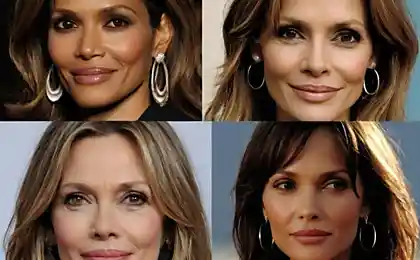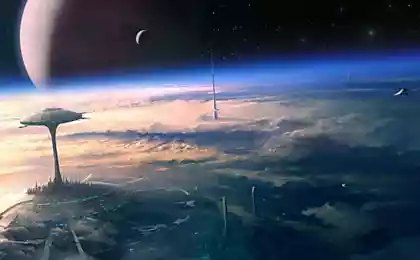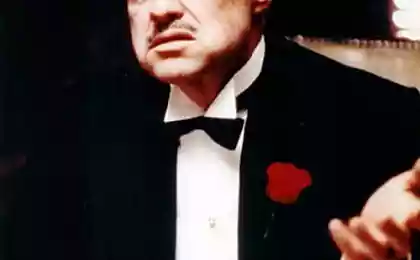747
Saga of generations. Why is the Su-27 is superior to the F-15
They have one sky for two. One way and another task - to sweep the skies of enemy aircraft. They - fighters to conquer air superiority. Birds fighting vehicles of the "first line", the elite of modern combat aircraft. Their complexity is prohibitive, and opportunities - are endless. They have too many advantages, but there are no disadvantages. They are strong and beautiful in their inexhaustible celestial fury. Eternal rivals - the Su-27 and F-15.
9 photos, and text. Source
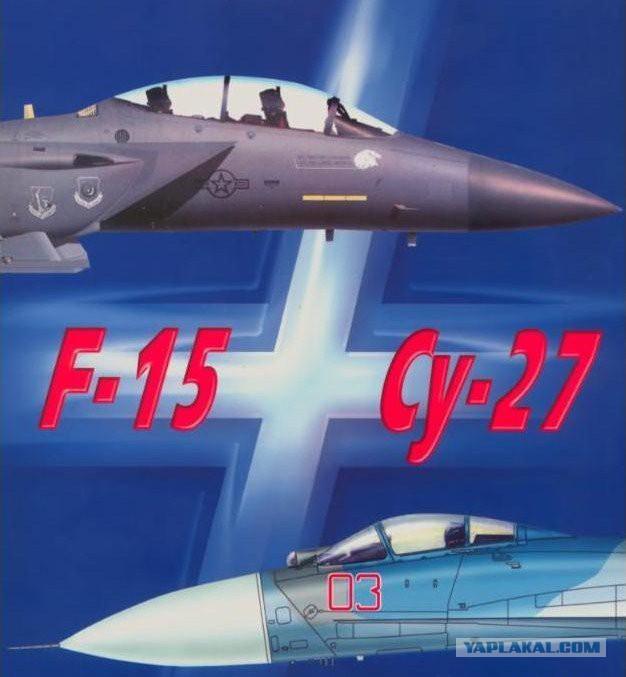
Who are you, gay cowboy?
His birth is associated with the war in Vietnam. The results of the meetings with the Soviet MiGs required to change the whole paradigm of previous US fighter aircraft. Air Force urgently needed highly mobile "killer MiGs," equally effective in close air combat and on medium and long distances. Outstanding radio-electronic "filling" must be enclosed in an equally perfect shell. American designers boldly took a step towards a new, fourth-generation fighter.
The first flight of "Eagle" was held in 1972. Four years later, the fighter F-15 Eagle was adopted. To date, these legendary air fighters gained 104 air victories - without a single defeat! "Nesbivaemye" angels of death, which can be defeated only by American arms. "Eagle" was knocked down only once - in 1995, the teachings of the Japanese Air Force F-15s was mistakenly shot down by the same F-15s.
The official report on the results of the combat use of "Eagle" described in other stories. According to the Yankees themselves, the level of control of Iraqi airspace during the Gulf War "had no historical precedent." Matches took place eight years later - "Eagles" tightly covered the sky over the Balkans.
But why are among the dozens of trophies "Eagle" There are no equal to him in the power of the aircraft? No "Eurofighter Typhoon" or "Dassault Rafale»?
The most notable trophies - nine light of the MiG-29 in the simplified export version. All other winning F-15s were won over the notoriously obsolete planes of the second and third generations of French "Mirage» F-1, Soviet Su-22 (export version of the Su-17), MiG-21, MiG-23, MiG-25 ...
Why do Americans always at war with aircraft of the previous generation? Not associated with this kind of a terrible secret? With this you need to understand.
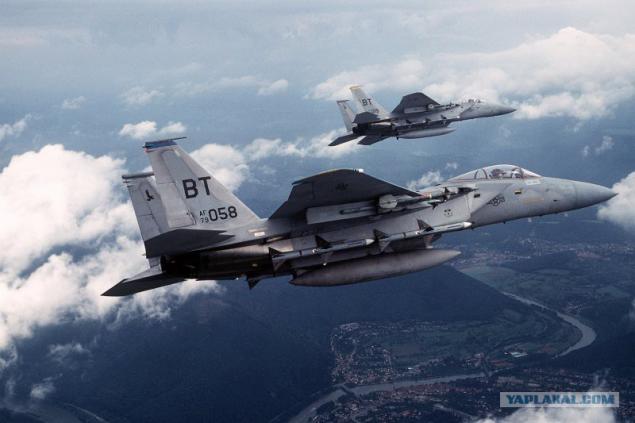
And here is the main competitor arrived "Eagle." Meet the gentlemen - a multipurpose highly mobile fourth-generation fighter Su-27.
Who are you, mysterious Russian soldier?
Daring Response to the West in the final stages of the Cold War.
At the turn of 70-80-ies in our country was established aviation masterpiece, designed to overshadow the US "Eagle." The plan failed completely: the domestic fighter 4th generation sets new standards in the field of military aviation.
Sukhoi design team was able to find a number of interesting decisions, related to the layout and the aerodynamics of future aircraft.
Artsy silhouette of the Su-27 is not similar to any of the foreign fighters. The graceful curve of the forward fuselage, a smooth transition to the wing, nacelle speakers - all of this is a consequence of the integral arrangement of aircraft in which lift is generated not only the plane of the wing, but also due to the special shape of the fuselage!
The enormous contribution made by experts in aerodynamics - the real genius of his craft. As a result, despite the similar value of the load on the wing (≈300 Kg / sq. M), lift coefficient "drying" and a half times higher than in the US "Eagle" and the maximum lift-drag ratio (ratio of lift to drag ratio) It reached 12 units (such values are found only in passenger airliners). Extremely "volatile" design!
The world's most advanced aerodynamic design made it possible to create a larger and heavier fighter. At the Su-27, compared to the "Iglom" has increased the internal fuel capacity, it provides greater range and neutralized cumbersome domestic REO (Soviet chip - the largest chips in the world!). Elastic "hand" wind power powerful pulling up the Su-27, despite the greater take-off weight of domestic cars.
Many have tried to engine specialists, creating a powerful "heart" for a great glider. The family of turbofan aircraft engines AL-31F engine with afterburner thrust of 13 tons! The high thrust-weight ratio (≥ 1) - the key to super-maneuverability and energetic maneuvers in the vertical plane.
According to the established value of climb of the Su-27 has no equal in the world (more than 300 m / s).
And our partners in China still can not copy high-temperature turbine blades AL-31F c labyrinth of the inner cavities, through which the cooling air. Apparently, their design was more complicated Swiss watches and Japanese electronics.
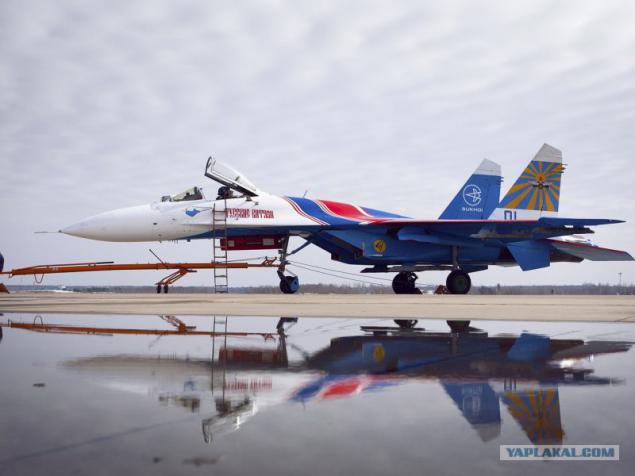
Finally, what can not be seen with the naked eye. The degree of longitudinal static stability of the Su-27 is negative and amounts to 5% of the mean aerodynamic chord of the wing (MAR). Of course, we are talking about flying at subsonic speeds.
What is the situation?
The longitudinal static stability of the angle of attack - the ability to independently maintain the plane a predetermined angle of attack α and return to the initial value α at random deviations under the influence of disturbing forces.
Sustainability - a pleasant thing in straight flight, but the fighter require high maneuverability. The higher the resistance (measured in% MAC) - the greater the loss on balance, worse handling and driving dynamics. To perform any maneuver required to exert more control moment, rejecting the control surfaces at a greater angle. Great efforts, the extra fraction of a second of precious time in the fight.
Stability flying plane determined by the position of the aerodynamic focus (in terms of growth of lift when the angle of attack), the center of gravity of the aircraft. The Su-27 was designed so that its focus is located in front of the aerodynamic DH. The aircraft every second is willing to raise the nose and "kuvyrknutsya" back through the tail. Without the participation of the pilot. It is statically unstable.
This makes the "drying" surprisingly nimble car, but the negative resistance is in contradiction with the requirements of handling. Requirement wire control system (Su-27 first Russian combat aircraft was equipped with FBWCS). In memory of a computer incorporated control efforts correct ratios for each of the flight modes - otherwise, man could not control the Su-27.
A reasonable question - what will happen in case of failure FBWCS? Despite the inadequate reaction "drying" in the motion control knob (RUS), an experienced pilot is likely to be able to hold on to the airfield and land the plane. Static instability MAR 5% - is still bearable.

But another member of the family, "the twenty-seventh," Su-35 failure FBWCS prescribe a couple of somersaults and broken for sure. The extent of his static instability increased to 20% MAC - control of the aircraft is possible in manual mode. However, the risk of such a situation is negligible - ESDU Su-35 performed a quadruple (!) Backup in the longitudinal channel and triple - channel lateral movement.
The brave member of the family - the Su-35

The integrated layout, powerful engines, the amazing beauty and effectiveness of aerodynamic configuration static instability ... Next - helmet-mounted target designation system "gap-ZOOM 'unique fighting method of" Cobra Pugacheva "guided missiles" Air-air "RVV-AE. After becoming acquainted with these facts of the dispute «F-15 vs. Su-27 "loses its meaning. The domestic fighter is much stronger and more perfect than its American peer.
The coeval?
When it was announced that I won, "McDonnell Douglas", "suhovtsy" sigh of relief: the layout embedded in the Su-27, looked much more promising. However, there were fears that the Americans slipped through the open seal their overseas counterparts "misinformation", and made themselves a completely different plane. However, after the official demonstration in 1972 the prototype "Igla" these fears vanished: it was clear that the experts "McDonnell Douglas" went on the most simple and cheap, but not the most promising path. Recalls Head of Project Sukhoi OS Samoylovich after takeoff YF-15 Head of TsAGI GP Svishchev Sukhoi said: "Pavel Osipovich! Our backlog has turned to our advantage. The plane took off and we know what it is ... »
Separation of fighters for generations largely arbitrary. Different weight categories, different levels of technological performance, for various purposes. It happened that in a single generation strangely coexisted 8-ton MiG-21 and 18-ton "Phantom" (despite the fact that the first is calculated on the Middle dogfight with cannon armament, and the second was hoping for a superradar and SD medium-range). They are united only by the fact that the concept turned out to be both generally misguided.
Often referred to the same generation machines, which lies between the creation of the whole temporal and technology gap. It is believed that the first fourth-generation fighter interceptor was an American carrier-based F-14 "Tomcat" (first flight - 1970 adopting - 1974). It looked good on the background of the "Phantoms", but after a couple of years is hopelessly outdated - in fact, he had no significant advantages over the F-15, but totally lost "Eagle" in close combat maneuvering. Result: The "Eagles" continue to fly until now, and the last "Tomcat" was decommissioned eight years ago.
Finally, modernization. As the old joke about the craftsmen that for a year and then upgraded the TV to sell it as a vacuum cleaner - how can you compare the first production Su-27s early 80s with the modern Su-35? How many pros need to put after the number "4" to fit these machines within a single generation?
The task is easier - how similar the F-15C of the sample 1980 and modernized F-15C beginning of the XXI century? The new version of the radar AN / APG-63 (V) 2 with active phased arrays, the new long-range missiles AIM-120 AMRAAM, new digital electronics - but it is actually a different aircraft with very different capabilities!
In order not to go into this interesting, but the endless dispute may be limited to one obvious conclusion: the fourth-generation fighter does exist as a collection of some of the general ideas. Key development trends - versatility, high maneuverability, high-quality and expensive avionics. Nevertheless, it is necessary to account for the fact that the era of fourth generation dragged on for more than 40 years - planes "early period" radically different from those that were created later.
Actually, this is the main difference between the F-15 from the Su-27, for which rarely pay attention to the authors of analytical articles devoted to these heroes - "Eagle" older "dry" for at least 10 years! As is evident from the passages quoted above history of the Su-27 - when the first F-15s took off, our fighter has not yet reached the stage of sketches.
Su-30, F-15C and Mirage-2000

Most indicated that the Su-27 made its first flight May 20, 1977, just five years later, "Eagle." But this deceit - the day in the air rose a prototype T-10-1, which had little to do with what we call the Su-27. In view of non-compliance characteristics of the prototype given values, it was decided to completely redesign the aircraft: have changed the profile of the wing and fuselage shape. Wing area increased from 59 to 62 meters. The ailerons and flaps were replaced by flaperons. The brake flap has moved from the lower surface to the upper surface of the fuselage, with a stay for canopy. Izmenilcya own canopy, the other was the layout of the rear of the aircraft, new suspension components ...
The new fighter prototype received the designation T-10S - in the figurative expression of chief designer Mikhail Simonov, on it from the T-10-1 preserved only tire wheel main landing gear, but the pilot ejection seat.
The first flight of the T-10C - April 1981. At this time, the American F-15s already in all exported and used in hostilities in the Middle East.
The first batch of serial fighter Su-27 was released in 1984. The first part of the drill, which received the Su-27 was the 60th IAP at the airport Dzemgi (Far IN) - its pilots started development of the newest aircraft in 1985.
By 1987, it was fully formed the basic elements of a complex aircraft Su-27 -was "adjusted" on-board radar N001 "Sword" and put into service the R-27 and R-73. The combat units there training Spark Su-27UB that accelerate and simplify the training of personnel. Around the same time began regular "meeting" of the Su-27 aircraft likely opponent - high-profile clash over the Barents Sea to the intelligence "Orion" Norwegian Air Force, dangerous proximity to American fighters during the exercise "Team Spirit" (Far East), and so on. d.
Finally, a pure formality - after successfully passing all tests, the Council of Ministers of the USSR on August 23, 1990 Su-27 was officially accepted by the Air Force and air defense of the Soviet Union.
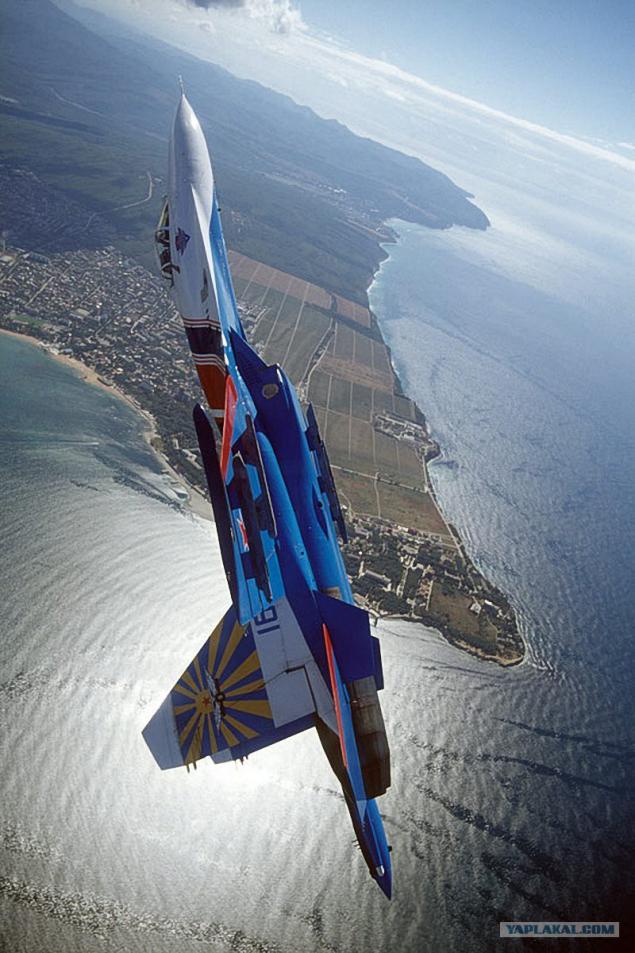
Epilogue
The stark truth is that by the time the Su-27, the American "Eagle" has considerably outdated.
Designers "McDonnell Douglas" ahead of time, built in 1976 superistrebitel, who for 10 years had no worthy opponents. This explains the large number of fighters the second and third generations, downed "Eagles».
MiG-23 (the beginning of operation - 1969 MiG-23ML - 1974), the MiG-25 (the beginning of operation - 1970) ... F-15 crumbled all of his peers.
The balance of power in the air changed only with the advent of the Su-27.
F-15D, trying to chase the Su-27, lost sight of him and in desperation sought observer "Where" Flenker »?» (Flanker - the code name for the Su-27 in NATO). "It is for you," - said the slave. Describes a "dogfight" received no coverage in the Western press.
- Visit of the Su-27 at the air base, "Langley." USA, 1992.
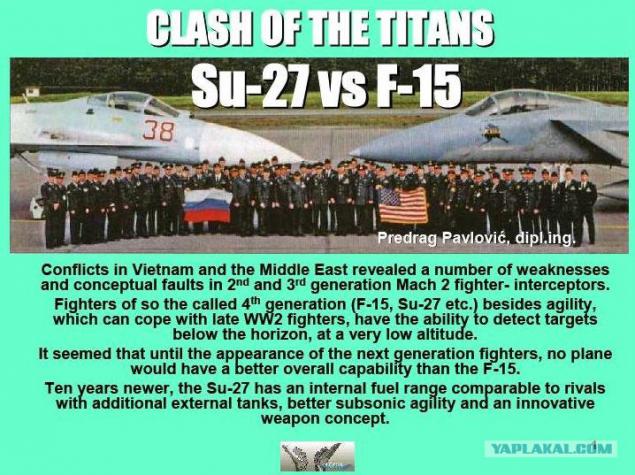
Source:
9 photos, and text. Source

Who are you, gay cowboy?
His birth is associated with the war in Vietnam. The results of the meetings with the Soviet MiGs required to change the whole paradigm of previous US fighter aircraft. Air Force urgently needed highly mobile "killer MiGs," equally effective in close air combat and on medium and long distances. Outstanding radio-electronic "filling" must be enclosed in an equally perfect shell. American designers boldly took a step towards a new, fourth-generation fighter.
The first flight of "Eagle" was held in 1972. Four years later, the fighter F-15 Eagle was adopted. To date, these legendary air fighters gained 104 air victories - without a single defeat! "Nesbivaemye" angels of death, which can be defeated only by American arms. "Eagle" was knocked down only once - in 1995, the teachings of the Japanese Air Force F-15s was mistakenly shot down by the same F-15s.
The official report on the results of the combat use of "Eagle" described in other stories. According to the Yankees themselves, the level of control of Iraqi airspace during the Gulf War "had no historical precedent." Matches took place eight years later - "Eagles" tightly covered the sky over the Balkans.
But why are among the dozens of trophies "Eagle" There are no equal to him in the power of the aircraft? No "Eurofighter Typhoon" or "Dassault Rafale»?
The most notable trophies - nine light of the MiG-29 in the simplified export version. All other winning F-15s were won over the notoriously obsolete planes of the second and third generations of French "Mirage» F-1, Soviet Su-22 (export version of the Su-17), MiG-21, MiG-23, MiG-25 ...
Why do Americans always at war with aircraft of the previous generation? Not associated with this kind of a terrible secret? With this you need to understand.

And here is the main competitor arrived "Eagle." Meet the gentlemen - a multipurpose highly mobile fourth-generation fighter Su-27.
Who are you, mysterious Russian soldier?
Daring Response to the West in the final stages of the Cold War.
At the turn of 70-80-ies in our country was established aviation masterpiece, designed to overshadow the US "Eagle." The plan failed completely: the domestic fighter 4th generation sets new standards in the field of military aviation.
Sukhoi design team was able to find a number of interesting decisions, related to the layout and the aerodynamics of future aircraft.
Artsy silhouette of the Su-27 is not similar to any of the foreign fighters. The graceful curve of the forward fuselage, a smooth transition to the wing, nacelle speakers - all of this is a consequence of the integral arrangement of aircraft in which lift is generated not only the plane of the wing, but also due to the special shape of the fuselage!
The enormous contribution made by experts in aerodynamics - the real genius of his craft. As a result, despite the similar value of the load on the wing (≈300 Kg / sq. M), lift coefficient "drying" and a half times higher than in the US "Eagle" and the maximum lift-drag ratio (ratio of lift to drag ratio) It reached 12 units (such values are found only in passenger airliners). Extremely "volatile" design!
The world's most advanced aerodynamic design made it possible to create a larger and heavier fighter. At the Su-27, compared to the "Iglom" has increased the internal fuel capacity, it provides greater range and neutralized cumbersome domestic REO (Soviet chip - the largest chips in the world!). Elastic "hand" wind power powerful pulling up the Su-27, despite the greater take-off weight of domestic cars.
Many have tried to engine specialists, creating a powerful "heart" for a great glider. The family of turbofan aircraft engines AL-31F engine with afterburner thrust of 13 tons! The high thrust-weight ratio (≥ 1) - the key to super-maneuverability and energetic maneuvers in the vertical plane.
According to the established value of climb of the Su-27 has no equal in the world (more than 300 m / s).
And our partners in China still can not copy high-temperature turbine blades AL-31F c labyrinth of the inner cavities, through which the cooling air. Apparently, their design was more complicated Swiss watches and Japanese electronics.

Finally, what can not be seen with the naked eye. The degree of longitudinal static stability of the Su-27 is negative and amounts to 5% of the mean aerodynamic chord of the wing (MAR). Of course, we are talking about flying at subsonic speeds.
What is the situation?
The longitudinal static stability of the angle of attack - the ability to independently maintain the plane a predetermined angle of attack α and return to the initial value α at random deviations under the influence of disturbing forces.
Sustainability - a pleasant thing in straight flight, but the fighter require high maneuverability. The higher the resistance (measured in% MAC) - the greater the loss on balance, worse handling and driving dynamics. To perform any maneuver required to exert more control moment, rejecting the control surfaces at a greater angle. Great efforts, the extra fraction of a second of precious time in the fight.
Stability flying plane determined by the position of the aerodynamic focus (in terms of growth of lift when the angle of attack), the center of gravity of the aircraft. The Su-27 was designed so that its focus is located in front of the aerodynamic DH. The aircraft every second is willing to raise the nose and "kuvyrknutsya" back through the tail. Without the participation of the pilot. It is statically unstable.
This makes the "drying" surprisingly nimble car, but the negative resistance is in contradiction with the requirements of handling. Requirement wire control system (Su-27 first Russian combat aircraft was equipped with FBWCS). In memory of a computer incorporated control efforts correct ratios for each of the flight modes - otherwise, man could not control the Su-27.
A reasonable question - what will happen in case of failure FBWCS? Despite the inadequate reaction "drying" in the motion control knob (RUS), an experienced pilot is likely to be able to hold on to the airfield and land the plane. Static instability MAR 5% - is still bearable.

But another member of the family, "the twenty-seventh," Su-35 failure FBWCS prescribe a couple of somersaults and broken for sure. The extent of his static instability increased to 20% MAC - control of the aircraft is possible in manual mode. However, the risk of such a situation is negligible - ESDU Su-35 performed a quadruple (!) Backup in the longitudinal channel and triple - channel lateral movement.
The brave member of the family - the Su-35

The integrated layout, powerful engines, the amazing beauty and effectiveness of aerodynamic configuration static instability ... Next - helmet-mounted target designation system "gap-ZOOM 'unique fighting method of" Cobra Pugacheva "guided missiles" Air-air "RVV-AE. After becoming acquainted with these facts of the dispute «F-15 vs. Su-27 "loses its meaning. The domestic fighter is much stronger and more perfect than its American peer.
The coeval?
When it was announced that I won, "McDonnell Douglas", "suhovtsy" sigh of relief: the layout embedded in the Su-27, looked much more promising. However, there were fears that the Americans slipped through the open seal their overseas counterparts "misinformation", and made themselves a completely different plane. However, after the official demonstration in 1972 the prototype "Igla" these fears vanished: it was clear that the experts "McDonnell Douglas" went on the most simple and cheap, but not the most promising path. Recalls Head of Project Sukhoi OS Samoylovich after takeoff YF-15 Head of TsAGI GP Svishchev Sukhoi said: "Pavel Osipovich! Our backlog has turned to our advantage. The plane took off and we know what it is ... »
Separation of fighters for generations largely arbitrary. Different weight categories, different levels of technological performance, for various purposes. It happened that in a single generation strangely coexisted 8-ton MiG-21 and 18-ton "Phantom" (despite the fact that the first is calculated on the Middle dogfight with cannon armament, and the second was hoping for a superradar and SD medium-range). They are united only by the fact that the concept turned out to be both generally misguided.
Often referred to the same generation machines, which lies between the creation of the whole temporal and technology gap. It is believed that the first fourth-generation fighter interceptor was an American carrier-based F-14 "Tomcat" (first flight - 1970 adopting - 1974). It looked good on the background of the "Phantoms", but after a couple of years is hopelessly outdated - in fact, he had no significant advantages over the F-15, but totally lost "Eagle" in close combat maneuvering. Result: The "Eagles" continue to fly until now, and the last "Tomcat" was decommissioned eight years ago.
Finally, modernization. As the old joke about the craftsmen that for a year and then upgraded the TV to sell it as a vacuum cleaner - how can you compare the first production Su-27s early 80s with the modern Su-35? How many pros need to put after the number "4" to fit these machines within a single generation?
The task is easier - how similar the F-15C of the sample 1980 and modernized F-15C beginning of the XXI century? The new version of the radar AN / APG-63 (V) 2 with active phased arrays, the new long-range missiles AIM-120 AMRAAM, new digital electronics - but it is actually a different aircraft with very different capabilities!
In order not to go into this interesting, but the endless dispute may be limited to one obvious conclusion: the fourth-generation fighter does exist as a collection of some of the general ideas. Key development trends - versatility, high maneuverability, high-quality and expensive avionics. Nevertheless, it is necessary to account for the fact that the era of fourth generation dragged on for more than 40 years - planes "early period" radically different from those that were created later.
Actually, this is the main difference between the F-15 from the Su-27, for which rarely pay attention to the authors of analytical articles devoted to these heroes - "Eagle" older "dry" for at least 10 years! As is evident from the passages quoted above history of the Su-27 - when the first F-15s took off, our fighter has not yet reached the stage of sketches.
Su-30, F-15C and Mirage-2000

Most indicated that the Su-27 made its first flight May 20, 1977, just five years later, "Eagle." But this deceit - the day in the air rose a prototype T-10-1, which had little to do with what we call the Su-27. In view of non-compliance characteristics of the prototype given values, it was decided to completely redesign the aircraft: have changed the profile of the wing and fuselage shape. Wing area increased from 59 to 62 meters. The ailerons and flaps were replaced by flaperons. The brake flap has moved from the lower surface to the upper surface of the fuselage, with a stay for canopy. Izmenilcya own canopy, the other was the layout of the rear of the aircraft, new suspension components ...
The new fighter prototype received the designation T-10S - in the figurative expression of chief designer Mikhail Simonov, on it from the T-10-1 preserved only tire wheel main landing gear, but the pilot ejection seat.
The first flight of the T-10C - April 1981. At this time, the American F-15s already in all exported and used in hostilities in the Middle East.
The first batch of serial fighter Su-27 was released in 1984. The first part of the drill, which received the Su-27 was the 60th IAP at the airport Dzemgi (Far IN) - its pilots started development of the newest aircraft in 1985.
By 1987, it was fully formed the basic elements of a complex aircraft Su-27 -was "adjusted" on-board radar N001 "Sword" and put into service the R-27 and R-73. The combat units there training Spark Su-27UB that accelerate and simplify the training of personnel. Around the same time began regular "meeting" of the Su-27 aircraft likely opponent - high-profile clash over the Barents Sea to the intelligence "Orion" Norwegian Air Force, dangerous proximity to American fighters during the exercise "Team Spirit" (Far East), and so on. d.
Finally, a pure formality - after successfully passing all tests, the Council of Ministers of the USSR on August 23, 1990 Su-27 was officially accepted by the Air Force and air defense of the Soviet Union.

Epilogue
The stark truth is that by the time the Su-27, the American "Eagle" has considerably outdated.
Designers "McDonnell Douglas" ahead of time, built in 1976 superistrebitel, who for 10 years had no worthy opponents. This explains the large number of fighters the second and third generations, downed "Eagles».
MiG-23 (the beginning of operation - 1969 MiG-23ML - 1974), the MiG-25 (the beginning of operation - 1970) ... F-15 crumbled all of his peers.
The balance of power in the air changed only with the advent of the Su-27.
F-15D, trying to chase the Su-27, lost sight of him and in desperation sought observer "Where" Flenker »?» (Flanker - the code name for the Su-27 in NATO). "It is for you," - said the slave. Describes a "dogfight" received no coverage in the Western press.
- Visit of the Su-27 at the air base, "Langley." USA, 1992.

Source:


